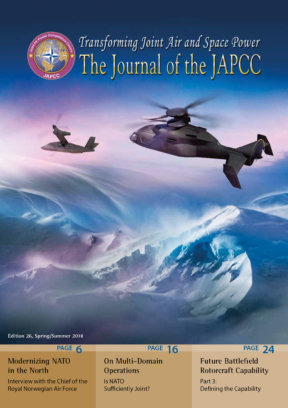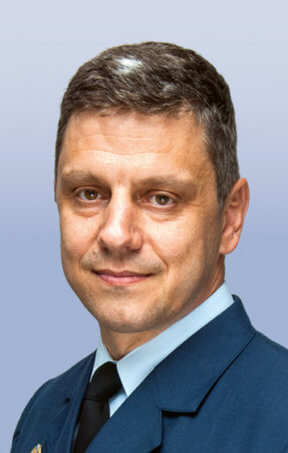Introduction
Destroying or disrupting an enemy’s air defence has long been central to any air campaign because it enables friendly air superiority/supremacy that protects friendly forces and allows freedom of movement. Without effective Suppression of Enemy Air Defence (SEAD), all other joint activities in a campaign carry a higher degree of risk. Historically, 15% to 30% of total flown sorties are tasked to conduct SEAD missions.1 SEAD is essential to the core roles of Joint Air Power, supporting the strategic effects of deterrence, prevention, and defence2. These effects can be destructive (lethal) and/or disruptive (non-lethal).
While the capabilities and intensity of enemy air defences have varied greatly over the last 50 years, combat aircraft losses due to enemy air defences have been extremely low in recent conflicts. Though Alliance SEAD platforms are not solely responsible for this favourable trend, it is clear that SEAD is an important contributor to aircraft survivability3.
However, the largely permissive environments of Iraq and Afghanistan have lulled the Alliance’s planners into overlooking a burgeoning problem: a new generation of increasingly sophisticated and capable enemy air defence threats that threaten to overwhelm NATO’s current SEAD abilities. The emergence of new traditional and non-traditional threats, such as very long range Surface to Air Missiles (SAMs), low observable air platforms, and cyber domain actors are already creating more complex and robust air defence systems. The question becomes: is NATO prepared to handle current air defence threats, let alone emerging ones? To answer that question, we must understand what SEAD is and is not. And to do that, we must understand where we came from, where we are, and where we are going.
SEAD Evolution
Electronic Warfare (EW) applications in operations were established in the early 20th century for communication and aerial target detection. Electromagnetic operations in the battlefield evolved rapidly between and during the two world wars4. Early warning radars and primitive air defence systems were developed during WW II, and particular countermeasures, such as chaff, were employed against these systems. During the pre-Vietnam war era, both eastern and western military forces shaped EW as a war fighting domain, while an early Command and Control (C2) system of air defence was also established.
The Vietnam War could be considered the watershed of systematically suppressing an enemy air defence.5 The North Vietnam Army had an established Integrated Air Defence System (IADS) dedicated to the denial of ‘blue’ freedom of air operations. Specific air platforms, anti-radiation air-to-surface weapons, electromagnetic effectors (e.g. jammers), and specific suppressive tactics were employed by US forces to suppress the Vietnamese IADS. In effect, the war in Vietnam was the catalyst for what would become known as SEAD, and also highlighted the value of effective SEAD in contested environments.
The post-Vietnam war era saw the development and employment of advanced Anti-Radiation Missiles (ARMs), specialized EW assets, and new air tactics for SEAD operations. In response, adversary IADS complexity evolved to complicate SEAD targeting and provide resilience to air defence systems. Indeed, the last 30 years of air campaigns, such as Libya in 1986 (and 2011), the Persian Gulf War in 1991, Bosnia in 1995, Kosovo in 1999, and to a lesser extent Iraq in 2001 and 2003 – stand as testament to increasingly complex IADS and the necessity of effective SEAD air operations as a key enabler during the campaigns.6 Much of the success of recent SEAD operations is due to the ability (and willingness) of Allied forces to address IADS in a somewhat flexible and holistic manner. For example, while it is not unusual for SEAD forces to employ anti-radiation missiles for the lethal suppression of enemy IADS assets, such as SAM Systems and Anti-Aircraft Artillery installations, forces have traditionally combined SEAD assets with EW platforms and tactics to support the suppression of the enemy IADS in a non-lethal manner, as well.
While there are successes in the SEAD arena, there are also misconceptions that may inhibit effective SEAD. For instance, many planners believe that SEAD = ARM (only), and that this wonder weapon suppresses every air defence threat. It does not take long to see the fallacy of this thought.
In Kosovo, despite the fact that Alliance SEAD operations made up 12 percent of total combat sorties,7 Serbian IADS assets adapted their tactics to balance lethality with survivability, and therefore, they remained resilient and mostly operational throughout the conflict.8 NATO assets launched over 750 ARM weapons9, with very few achieving lethal effects against Serbian IADS assets.10 Though suppression of the enemy air defence was eventually achieved, this was largely because Serbia was fighting with what could be considered inferior air defence assets and with limited support.
The need for increased SEAD operation ‘jointness’ was evident during the Libyan campaign in 2011, in which the suppression of the enemy’s IADS may have been accomplished, but not solely by traditional SEAD assets.11 For instance, attack helicopters based offshore were flying missions to strike radar sites, often in coordination with fixed-wing aircraft.12 Similarly, Libya regime military hard targets such as radars, missile launch sites and communication nodes, were struck by sea-launched cruise missiles.13 While the weapons the Libyan forces used were aged and less capable than those from near-peer competitors, the Libyan IADS was non-traditional.14 Libya’s IADS often used non-military infrastructure for Command, Control, and Communications (C3), which complicated targeting because of political and humanitarian concerns. For example, it used civilian air traffic systems to cue military IADS and incorporated modern commercial technology to counteract traditional SEAD targeting. Apart from the civilian infrastructure of the Libyan IADS, the urban Libyan territory, with its inherent potential for collateral damage, illustrated one of the many problems of using mainly ARMs to solve all SEAD problems.
A mere three years later, a resurgent Russia drastically changed the face of potential conflict in Europe and brought with it a host of interwoven air defence threats, most of which the Alliance had neither prepared nor practiced for. New, long-range (i.e. ‘double-digit’) SAMs, integrated and redundant command and control networks, ‘bastions’ of overlapping weapons engagement zones (WEZs) and an ability to orchestrate defence across multiple domains have drastically changed the SEAD environment. The term ‘Anti-Access/Area Denial (A2/AD)’15 has quickly become part of the SEAD lexicon. Indeed, merely shooting ARMs and hoping for the best will not do in this new environment.
The recent changes in the threat environment have brought the Alliance back to the SEAD drawing board, with a realization that our current SEAD capabilities may be inadequate for looming threats. There is a burgeoning realization that we must use all of the ‘joint tools’ at our disposal to address the threat.
SEAD Jointness – Back to the Future
The takedown of the Iraqi IADS in 1991 was indeed a joint affair, and it was an example of what is possible when we are willing to use all of the joint tools at our disposal.16 The coalition used air, land, SOF, and naval forces to degrade, destroy, and suppress the enemy’s air defence using a variety of weapons and effects. This joint approach to take down the Iraqi IADS, and subsequent support to SEAD, was a high point of thought and cooperation. However, the intervening years have seen dwindling SEAD assets and fissures in jointness. Additionally, while the Iraqi air defence was formidable, it pales in comparison to what the Alliance faces today.
Considering the core capabilities of potential NATO adversaries17, 18, it is apparent military threats are evolving towards a more ‘command-centric approach’. Also, technological innovations such as low observable and unmanned systems, advanced linked-communication, robotics, virtual reality, cyber, information, space, advanced computing power, biomimetic,19 and easy to access commercial-of-the-shelf (COTS) products are being employed by armed forces. Future battlefields will unmistakably be a complex, asymmetric environment.
Recent simulations and operational level exercises against bastions of ‘A2/AD’ demonstrate joint effects are crucial for success. No longer can one service expend a few high-value weapons and expect to operate with impunity. Various wargames have demonstrated the possibility of severe losses if the military components do not plan and execute a genuinely joint plan. Every branch and domain must operate in coordination to achieve the campaign goals. In other words, jointness of SEAD operations is a prerequisite for every future NATO campaign. Considering current NATO military competencies, the two main categories (kinetic and non-kinetic) may be addressed to describe currently available SEAD capabilities.
Kinetic SEAD capabilities may be described as an activity in which forces employ lethal munitions or weapons towards the suppression of enemy air defence. While specific air platforms have been developed to employ SEAD weapons, various assets can contribute effectively to the SEAD mission with a multitude of resources. Aside from ARMs, Stand-off/Cruise Weapons (SOW), Joint Direct Attack Munitions (JDAM), Direct Attack to Surface Missiles and Anti-Ship Missiles (ASM) may be employed by a variety of air power platforms against enemy air defence targets in accordance with operational constraints. Also, certain land, sub-surface and surface-based systems can launch kinetic weapons against air defence components. Finally, Special Operation Forces (SOF) may be employed to sabotage or destroy an adversary system which may support an IADS.
Conversely, any set of activities employed in the electromagnetic spectrum to deny, neutralize, disable, or disrupt hostile electromagnetic operations and suppress an enemy air defence can be considered as non-kinetic capabilities of EW in support of SEAD operations. An IADS is a complex system that not only consists of emitting radars, surface-to-air missile systems or air defence aircraft but also communication systems/nodes and data links. Both industry and the military have developed weapons which can produce effects on the adversary’s electromagnetic spectrum capabilities (i.e. C3 networks). Current examples include the use of the EF-18 Growler, the EC-130 Compass Call and experimentation with directed energy weapons.
Lastly, airborne decoy systems may contribute efficiently to SEAD operations. For example, a Miniature Air-Launched Decoy (MALD), which might be a small jet-powered aircraft appearing like a full-size aeroplane or a cruise missile, may trigger the enemy air defence system if it is flying in the SAMs’ effective ranges. As a result, this may lead to dissipation of adversary SAM ammunition stocks. Even more importantly, the details of the enemy’s air defence systems may be recorded and critical nodes subsequently targeted by SEAD forces. In effect, even though decoys may or may not employ a direct effect on an enemy air defence system, these systems can collect valuable information on enemy IADS and enable lethal or non-lethal SEAD courses of action.
Putting It All Together
The Alliance has various kinetic and non-kinetic capabilities that can be used for SEAD. Aside from the weapons, the awareness and willingness to address threats from a joint perspective is the last piece of the puzzle. Efforts are currently underway in NATO to educate the joint community about the latest air defence threats and what will be required to survive and thrive in a potentially dangerous environment. While not a panacea for all that ails the Alliance, this education is already beginning to show dividends through a resurgent joint mindedness, especially in regards to SEAD.
Potential adversaries’ military technology transformation and the continuously developing A2/AD capabilities dictate that jointness will continue to be required during SEAD operations. SEAD is not just shooting an ARM, it is a core capability of Alliance joint power (not solely air), in which air and surface, and even space or cyber operations, should be executed jointly for effective suppression of air defences. Therefore, it’s not enough to simply put joint capabilities in the same mission set, but you also need an agile way of commanding and controlling them. Consequently, NATO should consider developing C2 procedures that enable Joint SEAD operations to be effectively directed in accordance with operational domains’ activities, demands and restraints.
Even though many SEAD challenges are expected in the complex, asymmetric battlefield environment of the future, the first challenge is likely to remain jointness. Recent military campaigns demonstrate jointness is a perishable skill and requires careful thought and practice. In the end, while air defence systems may become more lethal and complex, the best weapon against them will be our willingness to work together.










